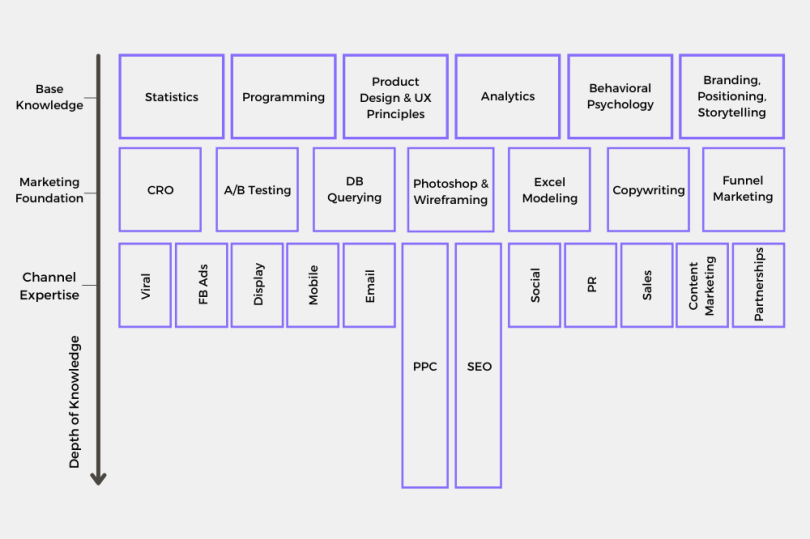Mark Spera didn’t plan on becoming a growth hacker, but when he launched an online clothing retailer in 2012, he had no choice but to embrace his new identity.
“It was a matter of starting a company and being like, ‘Oops, how do I get customers?’” Spera told Built In. “It was a necessity.”
What Is a Growth Hacker?
A growth hacker is someone who iteratively tests and optimizes various user activation, marketing or product strategies to grow a business, often a fast-growing tech startup. Growth hackers use data-driven tactics to improve the metrics tied to business growth.
To drive traffic to his e-commerce site, Spera began running small tests with paid search ads, paid social ads and organic search. He made incremental changes, taking special notice of what channels got the most traction and what variables delivered the most bang for his buck.
He also A/B tested his site’s product pages, tweaking description copy and photos to see which variations converted visitors into customers at the most efficient rate.
Then he repeated the winning formulas over and over.
Spera sums up what he was doing as “data-driven experimentation for the purpose of growing a business” — aka, growth hacking.
Who Are Growth Hackers?
Spera — now the head of growth at Minted and founder of the SEO tool GrowthBar — doesn’t call himself a growth hacker. Nobody really does anymore (probably because the name conjures up an image of a hoodie-wearing cybercriminal engaging in shadowy practices).
The term “growth hacking” was coined in 2010 by tech entrepreneurs Sean Ellis, Hiten Shah and Patrick Vlaskovits. They used it to describe the short-term strategies used by some companies to quickly and affordably acquire and retain lots of users.
These days, you’ll find people in this line of work possessing more innocuous titles like “growth marketer,” “digital marketing manager” and maybe even “growth product manager.”
If that last one sounds like a curveball, it’s because growth hacking is commonly associated with marketing. But, in actuality, the line between product and marketing is increasingly blurring. In fact you’ll often find many companies have a dedicated growth team because of this overlap.
“Growth teams really become a bridge between those two traditional departments,” Chang Chen, head of growth and marketing at Otter.ai, told Built In. “[They] really show you how to connect the marketing effort with user experience.”
Whatever you call these growth-focused professionals, the important thing to know is that they typically analyze the entire funnel — the journey customers take from awareness and acquisition down to retention and referral — and implement tests to figure out what levers they need to pull to unlock business growth.
Then they repeat that action over and over, helping the business scale up quickly and sustainably.
And in a competitive startup environment, where growth is often prized above all else, growth hackers remain in high demand.
“I think [growth professionals are] always going to be a demand,” Eric Siu, CEO of ClickFlow, previously told Built In. “As long as there’s businesses and there is Earth, then I think it will be needed.”
Growth Hacker Responsibilities
There were no data-obsessed growth hackers in the days of “Mad Men.” Preoccupied with catchy commercial jingles and clever billboard taglines, the marketers of Cold War-era Madison Avenue trafficked in brand awareness and brand equity, bearing little responsibility for how their work actually affected a business’s bottom line.
That sits in stark contrast with today’s growth hackers, whose job it is to stay laser-focused on improving whatever key metric is identified as being most closely related to their business’s growth.
The key metric is known as a “North Star metric,” labeled as such because it functions as a guiding light for growth hackers; more than any other number, the North Star metric is meant to indicate that business is booming.
North Star metrics look different for every company. For marketplaces (like Uber, Cameo, Airbnb), it’s usually the number of bookings that take place on their sites. For social media platforms, it’s typically user engagement, reflected in the number of daily or monthly active users. And for companies that sell freemium B2B SaaS tools, the North Star metric is often paid users.
Whatever the business model, it’s the growth hacker’s job to identify the North Star metric that aligns closest to growth, and then to figure out what actions to take that’ll cause that number to rapidly get bigger.
A Day in the Life of a Growth Hacker
A growth hacker’s main objective is to rapidly grow a business by improving its North Star metric, whether that’s conversions, engagement or something else. And to do that, they have to carry out certain actions — “growth hacks,” if you will — that will make it tick upward.
To learn what growth hacks work, growth hackers need to first identify opportunities by creating and testing hypotheses, to see if they move the needle.
In his book Growth Hacking for Dummies, growth executive Anuj Adhiya recommends creating a hypothesis statement using the following format:
- Because we saw [data/feedback]
- We expect that [change] will cause [impact].
- We’ll measure this using [metric].
Putting it in a real-life context, Adhiya gives this example:
- Because we saw confusion regarding how to register a demo
- We expect that changing the call-to-action copy will cause more demo registrations.
- We’ll measure this using # of demo signups.
This template can be applied to any number of scenarios and places along the funnel, like:
- Paid search and social channels.
- SEO content marketing.
- PR or influencer campaigns.
- Homepages, landing pages, product pages, checkout pages.
- Email marketing campaigns.
- Referral programs.
In the day to day, then, growth hackers can be seen:
- Creating, prioritizing and implementing tests.
- Monitoring their dashboards and analyzing various channel performance.
- Making slight changes to copy, creative or ad spend.
- Generating reports to get the rest of the team up to speed.
From there, it’s mostly just iterating on what they did the day before. And hopefully, it involves seeing growth too.
How to Be a Successful Growth Hacker
It’s often said that a growth hacker’s skill set should look like a T.
The “T-shaped marketer” concept, popularized by growth expert Brian Balfour, refers to someone who possesses a wide range of basic digital marketing and product skills, but who also has deep expertise in one or two specific areas. Visually, this skillset resembles the shape of the letter T.

The thought is that growth hackers need to be good enough at lots of things, since flexibility and a breadth of knowledge is particularly useful in hyper-growth startup environments, where people are often asked to wear lots of hats.
And they also need to be really good at a couple things, whether it’s a combination of, say, email marketing and social media marketing, or viral marketing and affiliate marketing. Ideally, the growth hacker’s deep specialties align with the channels on which the business finds (or anticipates finding) the most traction.
“Having familiarity across the board is important, because what works for one business doesn’t necessarily work for the other,” Spera said. “You have to have this awareness of all the channels and what’s going on, so you can pick and choose a little bit.”
Spera, for example, is well-versed in conversion rate optimization, running paid search and social ad campaigns, and plenty of other things. But SEO strategy is where he’s “staked [his] claim a little bit in growth marketing.” It’s the stem of his T.
“Having familiarity across the board is important, because what works for one business doesn’t necessarily work for the other.”
In addition to having a breadth of knowledge, being adept at collecting and analyzing data is the most important asset growth hackers can have in their toolboxes, Spera said. If the job is about anything, it’s about listening to the data, learning what’s working and what’s not working, following it wherever it leads.
Kristin Eberth, head of growth at Input Logic, told Built In that growth hacking is both an art and a science.
“I think if you really enjoy the art of customer experience, product design and marketing, and the science of testing and looking at data … then it’s the kind of role that people can find really enjoyable,” she said.
But what really makes growth hackers tick, Eberth said, is an enjoyment of learning.
“That’s fundamentally what the job is anyway,” she added. “You can’t just come in and have an answer. For any business, you have to be really curious about what’s happening and not be married to any one viewpoint.”




